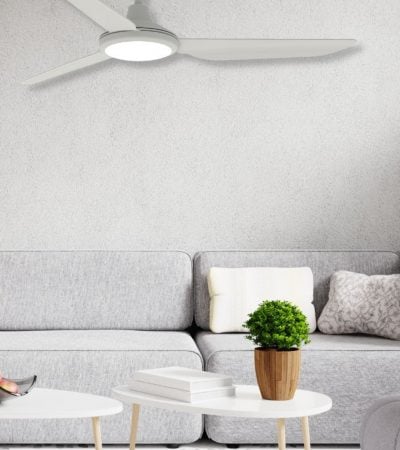
Shop the best price on ceiling fans with our lowest fan price guarantee!
Shop the best price on ceiling fans with our lowest fan price guarantee!
To NSW, ACT & VIC, and metro QLD & SA*
If you find a lower price, we’ll match it!
Sign up for exclusive VIP discounts all year round!
Ceiling fans really have become a staple in Australian households. Perfect for circulating the air in your home all year round, they are also the go to choice for helping cool your home in summer, and increasingly, for helping heat your home in winter.
Why are ceiling fans a popular choice?
With all those benefits, it is easy to see why ceiling fans are a home “must have”. But, how do you decide which ceiling fan is right for you and your home? A lot of this will come down to price and design, however, one of the biggest considerations is deciding between an AC or a DC ceiling fan.
When we refer to AC or DC, we are referring to the way current flows within a circuit to generate power. Alternating Current (AC), simply means that the current flows in alternating directions, back and forth. Direct Current (DC), as its name suggests, refers to current that flows in a single direction.
While we could go into a lot of technical detail about the differences between AC and DC, what we really want to know is what this means for your ceiling fan.
In any ceiling fan, a force needs to be generated that is strong enough to rotate the rotor, and push the fan blades. In a ceiling fan with an AC motor, this force is generated directly from the power source. In a ceiling fan with a DC motor, the power source connects to a transformer, which converts the AC power to DC, and then uses magnets to create the force needed to rotate the motor’s rotor.
Both AC and DC ceiling fans require the same force to rotate the motor’s rotor, and push the blades. The resulting difference between the two, however, is the amount of energy required directly from the power source to do this.
With that in mind, let us help you decide whether your next ceiling fan will have an AC or DC motor by looking at some of the pros and cons of each.



Both these types of fans have their strong and weak sides. However, they are both effective for keeping the temperature in your space comfortable. That is why choosing between AC and DC ceiling fan is like choosing your cup of tea. When the time comes to pick your ceiling fan – don’t sweat it. Simply remember the differences between the two types and focus on the features that are important to you in the device of your choice.
Or, chat to one of our ceiling fan experts. We can guide you through the pros and cons, and help you find the ceiling fan that is right for your space.
Become a Rovert VIP to unlock exclusive savings & offers!
Shop VIP prices
PLUS save $10 on your first
online order over $100!
